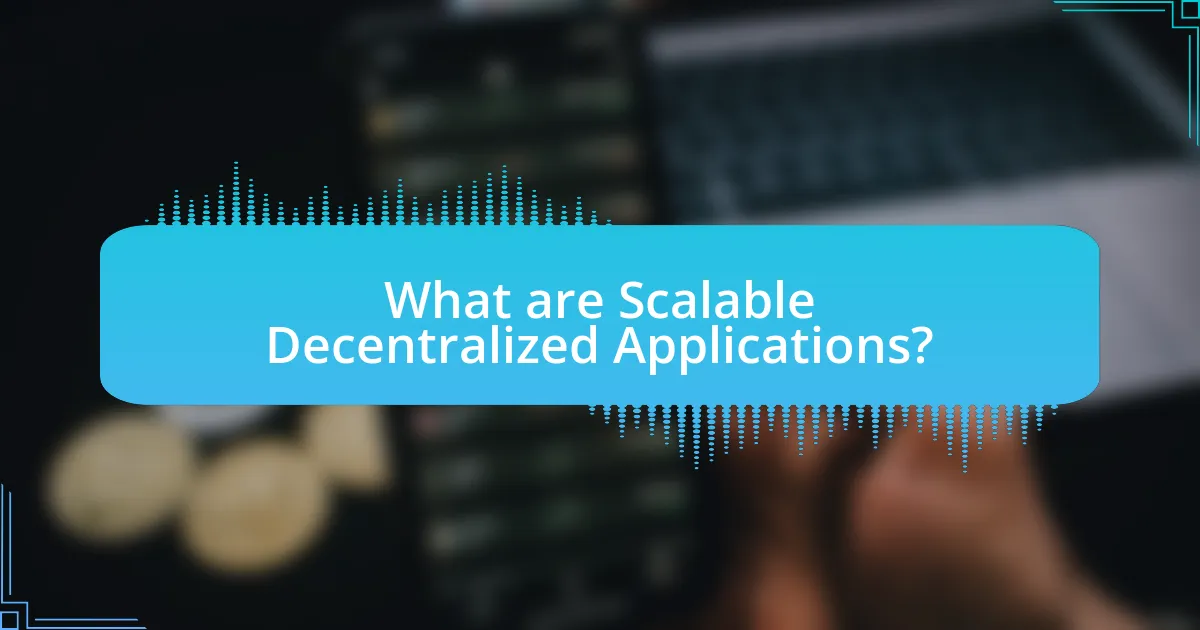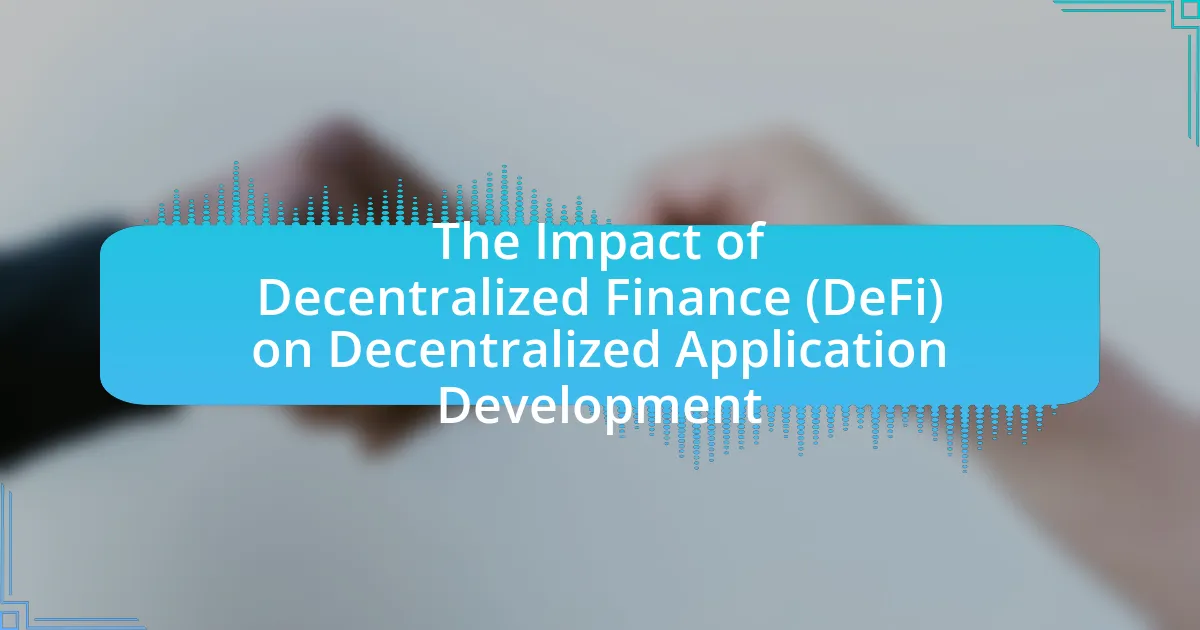Scalable decentralized applications (dApps) are software solutions that operate on blockchain networks, designed to efficiently manage increasing user loads and transaction volumes without sacrificing performance. This article explores the fundamental differences between dApps and traditional applications, highlighting their decentralized architecture, governance, and key characteristics such as modularity and consensus mechanisms. It addresses the importance of scalability for user satisfaction and operational efficiency, while also discussing the challenges developers face, including network congestion and security concerns. Furthermore, the article outlines effective strategies for building scalable dApps, including the use of layer-2 solutions, optimization techniques, and best practices for resource management, ultimately providing a comprehensive guide for developers in the blockchain space.

What are Scalable Decentralized Applications?
Scalable decentralized applications (dApps) are software applications that operate on a blockchain or decentralized network and can efficiently handle an increasing number of users or transactions without compromising performance. These applications leverage distributed computing resources, allowing them to scale horizontally by adding more nodes to the network, which enhances their capacity to process data and transactions. For instance, Ethereum, a popular platform for dApps, has implemented layer-2 solutions like Optimistic Rollups to improve transaction throughput and reduce costs, demonstrating the feasibility of scalability in decentralized environments.
How do Scalable Decentralized Applications differ from traditional applications?
Scalable decentralized applications (dApps) differ from traditional applications primarily in their architecture and governance. dApps operate on a distributed network, utilizing blockchain technology, which allows for greater transparency, security, and resistance to censorship compared to centralized applications that rely on a single server or entity for control. For instance, while traditional applications can be vulnerable to single points of failure, dApps leverage consensus mechanisms to validate transactions across multiple nodes, enhancing reliability and scalability. This decentralized nature also enables users to maintain control over their data, contrasting with traditional applications where user data is often stored and managed by the service provider.
What are the key characteristics of Scalable Decentralized Applications?
Scalable Decentralized Applications (dApps) are characterized by their ability to efficiently handle increasing loads while maintaining decentralization and security. Key characteristics include modular architecture, which allows for independent scaling of components; consensus mechanisms that ensure transaction integrity without central authority; and interoperability, enabling seamless interaction with other dApps and blockchain networks. Additionally, scalability is often achieved through layer-2 solutions, such as state channels or sidechains, which enhance transaction throughput. These characteristics are essential for supporting a growing user base and complex functionalities in a decentralized environment.
Why is scalability important for Decentralized Applications?
Scalability is crucial for decentralized applications because it ensures that the application can handle an increasing number of users and transactions without compromising performance. As decentralized applications grow in popularity, they must efficiently manage higher loads to maintain user satisfaction and operational efficiency. For instance, Ethereum, a leading platform for decentralized applications, faced significant congestion during peak usage times, leading to slow transaction speeds and high fees, which highlighted the need for scalable solutions. Therefore, scalability directly impacts the usability and adoption of decentralized applications, making it a fundamental aspect of their design and development.
What challenges do developers face when building Scalable Decentralized Applications?
Developers face several challenges when building scalable decentralized applications, primarily including network congestion, limited throughput, and high latency. Network congestion occurs due to the decentralized nature of blockchain technology, where increased user activity can lead to slower transaction processing times. Limited throughput is a significant issue, as many blockchain platforms can only handle a small number of transactions per second; for instance, Bitcoin processes about 7 transactions per second, while Ethereum handles around 30. High latency can arise from the time it takes for transactions to be confirmed across a distributed network, which can hinder user experience. These challenges necessitate innovative solutions such as layer-2 scaling solutions, sharding, and improved consensus mechanisms to enhance performance and usability in decentralized applications.
How do network latency and throughput affect scalability?
Network latency and throughput significantly impact scalability by determining how quickly and efficiently a system can handle increased loads. High latency can lead to delays in data transmission, which hampers the responsiveness of applications as they scale. For instance, a study by Google found that a 100-millisecond increase in latency can reduce conversions by 7%. Conversely, high throughput allows a system to process more data simultaneously, facilitating better performance under heavy loads. According to research from Akamai, a 1-second delay in page load time can lead to a 7% reduction in conversions, highlighting the importance of optimizing both latency and throughput for scalable applications. Thus, managing these factors is crucial for maintaining performance as user demand grows.
What security concerns arise in Scalable Decentralized Applications?
Security concerns in scalable decentralized applications include vulnerabilities to smart contract exploits, data privacy issues, and network attacks. Smart contracts can contain bugs or logic flaws that malicious actors can exploit, leading to financial losses or unauthorized access to assets. Data privacy is compromised when sensitive information is stored on public ledgers, making it accessible to anyone. Additionally, decentralized networks can be susceptible to Distributed Denial of Service (DDoS) attacks, which can disrupt service availability. These concerns highlight the need for rigorous security audits, privacy-preserving technologies, and robust network defenses to mitigate risks in decentralized applications.

What are the key strategies for building Scalable Decentralized Applications?
The key strategies for building scalable decentralized applications include utilizing layer-2 solutions, optimizing smart contract efficiency, and implementing effective data storage techniques. Layer-2 solutions, such as state channels and sidechains, enhance transaction throughput by processing transactions off the main blockchain, thereby reducing congestion. Optimizing smart contract efficiency involves minimizing gas costs and execution time, which can be achieved through code optimization and using efficient algorithms. Effective data storage techniques, such as IPFS or decentralized databases, ensure that data retrieval is fast and reliable while maintaining decentralization. These strategies are validated by the growing adoption of layer-2 solutions in projects like Polygon and the emphasis on gas optimization in Ethereum’s EIP-1559 upgrade, which demonstrates the industry’s focus on scalability.
How can developers ensure efficient resource management?
Developers can ensure efficient resource management by implementing optimization techniques such as load balancing, resource allocation algorithms, and monitoring tools. Load balancing distributes workloads evenly across servers, preventing any single server from becoming a bottleneck, which is crucial for maintaining performance in decentralized applications. Resource allocation algorithms dynamically assign resources based on current demand, ensuring that resources are utilized effectively without waste. Monitoring tools provide real-time insights into resource usage, allowing developers to identify inefficiencies and adjust accordingly. These strategies collectively enhance the scalability and performance of decentralized applications, as evidenced by studies showing that optimized resource management can improve application responsiveness by up to 40%.
What role does load balancing play in scalability?
Load balancing is crucial for scalability as it distributes incoming network traffic across multiple servers, ensuring no single server becomes overwhelmed. This distribution allows applications to handle increased loads efficiently, maintaining performance and availability as user demand grows. For instance, a study by the University of California, Berkeley, highlights that effective load balancing can improve resource utilization by up to 80%, directly correlating with enhanced scalability in decentralized applications.
How can caching improve performance in Decentralized Applications?
Caching can significantly improve performance in Decentralized Applications (dApps) by reducing latency and minimizing the load on the underlying blockchain network. By storing frequently accessed data locally or in a distributed cache, dApps can quickly retrieve information without repeatedly querying the blockchain, which is often slower due to its consensus mechanisms. For instance, a study by the Ethereum Foundation highlights that caching can decrease response times by up to 80% in certain scenarios, thereby enhancing user experience and scalability. This reduction in blockchain queries not only speeds up data retrieval but also lowers transaction costs associated with on-chain operations, making dApps more efficient and user-friendly.
What architectural patterns are effective for scalability?
Microservices architecture is an effective architectural pattern for scalability. This pattern allows applications to be divided into smaller, independent services that can be developed, deployed, and scaled individually. By enabling horizontal scaling, microservices can handle increased loads by adding more instances of specific services rather than scaling the entire application. According to a 2020 study by the Cloud Native Computing Foundation, 92% of organizations reported improved scalability after adopting microservices. Additionally, event-driven architecture is another effective pattern, as it allows systems to respond to events asynchronously, facilitating better resource utilization and responsiveness under varying loads.
How does microservices architecture contribute to scalability?
Microservices architecture contributes to scalability by allowing individual services to be developed, deployed, and scaled independently. This modular approach enables organizations to allocate resources dynamically based on the specific demands of each service, facilitating efficient scaling without affecting the entire application. For instance, if a particular service experiences high traffic, it can be scaled up independently, while other services remain unaffected, optimizing resource utilization and performance. This capability is supported by cloud platforms that offer auto-scaling features, further enhancing the scalability of microservices-based applications.
What is the significance of using blockchain technology for scalability?
Blockchain technology is significant for scalability because it enables decentralized applications to handle increased transaction volumes without compromising security or performance. By utilizing mechanisms such as sharding, layer-2 solutions, and consensus algorithms, blockchain can distribute workloads efficiently across multiple nodes. For instance, Ethereum’s transition to a proof-of-stake model and the implementation of rollups have demonstrated substantial improvements in transaction throughput, allowing the network to process thousands of transactions per second. This scalability is crucial for supporting a growing user base and facilitating complex applications in real-time, thereby enhancing the overall utility and adoption of decentralized technologies.

What best practices should be followed when developing Scalable Decentralized Applications?
When developing scalable decentralized applications, it is essential to implement best practices such as optimizing smart contracts, utilizing layer-2 solutions, and ensuring efficient data storage. Optimizing smart contracts reduces gas fees and enhances transaction speed, which is crucial for scalability. Layer-2 solutions, like state channels or sidechains, alleviate congestion on the main blockchain, allowing for faster and cheaper transactions. Efficient data storage techniques, such as off-chain storage for large datasets, minimize on-chain data load, improving overall application performance. These practices are supported by industry examples, such as Ethereum’s adoption of layer-2 solutions like Polygon, which has significantly increased transaction throughput while reducing costs.
How can developers optimize smart contracts for scalability?
Developers can optimize smart contracts for scalability by implementing techniques such as reducing computational complexity, minimizing storage usage, and utilizing off-chain solutions. Reducing computational complexity involves simplifying algorithms and minimizing the number of operations required for execution, which can significantly lower gas costs and improve transaction speed. Minimizing storage usage is crucial, as on-chain storage is expensive; developers can achieve this by using more efficient data structures and avoiding unnecessary state variables. Utilizing off-chain solutions, like state channels or layer-2 protocols, allows for transactions to be processed outside the main blockchain, thereby alleviating congestion and enhancing throughput. These strategies collectively contribute to more efficient smart contracts that can handle a higher volume of transactions, as evidenced by successful implementations in projects like Optimism and Polygon, which have demonstrated significant improvements in scalability.
What techniques can be used to minimize gas fees in smart contracts?
To minimize gas fees in smart contracts, developers can implement several techniques, including optimizing code efficiency, using layer-2 scaling solutions, and batching transactions. Optimizing code efficiency involves reducing the complexity of smart contract functions, which can significantly lower gas consumption; for instance, using simpler data structures and minimizing storage operations can lead to cost savings. Layer-2 scaling solutions, such as Optimistic Rollups or zk-Rollups, allow transactions to be processed off-chain, reducing the load on the main blockchain and consequently lowering fees. Batching transactions enables multiple operations to be executed in a single transaction, which can also reduce the overall gas fees incurred. These strategies are supported by various studies indicating that optimized smart contracts can save up to 50% in gas fees compared to unoptimized ones.
How can testing and monitoring enhance application performance?
Testing and monitoring enhance application performance by identifying bottlenecks and ensuring optimal resource utilization. Through systematic testing, developers can detect issues such as memory leaks, slow response times, and inefficient algorithms before deployment. Monitoring tools provide real-time insights into application behavior, allowing for immediate adjustments based on user interactions and system load. For instance, a study by the IEEE on software performance metrics indicates that applications with regular performance testing and monitoring can achieve up to 30% better efficiency in resource usage. This proactive approach not only improves user experience but also reduces operational costs associated with downtime and performance degradation.
What tools and frameworks are available for building Scalable Decentralized Applications?
Tools and frameworks available for building scalable decentralized applications include Ethereum, Hyperledger Fabric, and IPFS. Ethereum provides a robust platform for smart contracts and decentralized applications, supporting scalability through layer-2 solutions like Optimistic Rollups and zk-Rollups. Hyperledger Fabric offers a modular architecture for enterprise-grade blockchain solutions, enabling scalability through its permissioned network structure. IPFS (InterPlanetary File System) enhances scalability by providing a distributed file storage system that allows applications to efficiently manage large amounts of data across a decentralized network. These tools and frameworks are widely recognized for their capabilities in supporting scalable decentralized applications.
Which development frameworks are most popular for Decentralized Applications?
The most popular development frameworks for Decentralized Applications (dApps) are Ethereum, Hyperledger Fabric, and Truffle. Ethereum is widely recognized for its robust smart contract capabilities and extensive developer community, making it a leading choice for dApp development. Hyperledger Fabric offers a modular architecture that supports enterprise-level applications, emphasizing privacy and scalability. Truffle, as a development environment and testing framework, streamlines the process of building and deploying smart contracts on Ethereum, further enhancing developer productivity. These frameworks are validated by their widespread adoption in the blockchain ecosystem, with Ethereum hosting thousands of dApps and Hyperledger being utilized by major corporations for private blockchain solutions.
How can developers leverage cloud services for scalability?
Developers can leverage cloud services for scalability by utilizing elastic computing resources that automatically adjust to varying workloads. This capability allows applications to handle increased traffic without manual intervention, ensuring optimal performance. For instance, platforms like Amazon Web Services (AWS) and Microsoft Azure offer auto-scaling features that dynamically allocate resources based on real-time demand, which can lead to cost savings and improved user experience. According to a report by Gartner, organizations that adopt cloud services can achieve up to 30% reduction in infrastructure costs while enhancing their scalability capabilities.
What are the common pitfalls to avoid in building Scalable Decentralized Applications?
Common pitfalls to avoid in building scalable decentralized applications include underestimating network latency, neglecting user experience, and failing to implement effective governance mechanisms. Underestimating network latency can lead to performance issues, as decentralized systems often experience delays due to their distributed nature. Neglecting user experience can result in low adoption rates, as complex interfaces deter users. Additionally, failing to implement effective governance mechanisms can lead to conflicts and inefficiencies, as seen in projects like DAO, which faced challenges due to lack of clear decision-making processes.
How can over-engineering impact scalability?
Over-engineering can significantly hinder scalability by introducing unnecessary complexity into a system. This complexity can lead to increased resource consumption, slower performance, and difficulties in maintaining and updating the application. For instance, a study by the Standish Group found that 45% of software projects fail due to excessive complexity, which directly impacts their ability to scale effectively. Additionally, over-engineered systems often require more time and effort to adapt to changing demands, making it challenging to scale efficiently in response to user growth or evolving requirements.
What mistakes should be avoided in user experience design?
In user experience design, mistakes to avoid include neglecting user research, which can lead to a misalignment between user needs and design solutions. Failing to conduct user testing can result in usability issues that go unnoticed until after launch, negatively impacting user satisfaction. Additionally, overcomplicating navigation can confuse users, making it difficult for them to achieve their goals. Ignoring accessibility standards can alienate users with disabilities, limiting the product’s reach. Lastly, not iterating based on user feedback can stifle improvement and innovation, ultimately hindering the product’s success.
What practical tips can help developers succeed in building Scalable Decentralized Applications?
To succeed in building scalable decentralized applications, developers should prioritize modular architecture, which allows for independent scaling of components. This approach enhances flexibility and performance, enabling developers to optimize specific parts of the application without affecting the entire system. Additionally, utilizing layer-2 solutions, such as state channels or sidechains, can significantly improve transaction throughput and reduce costs, as evidenced by Ethereum’s adoption of these technologies to alleviate network congestion. Implementing efficient consensus mechanisms, like Proof of Stake, can also enhance scalability by reducing energy consumption and increasing transaction speed. Furthermore, developers should focus on optimizing smart contracts for gas efficiency, as this directly impacts the cost and speed of transactions on the blockchain. Lastly, thorough testing and monitoring of the application in real-world scenarios can help identify bottlenecks and areas for improvement, ensuring the application remains scalable as user demand grows.

















